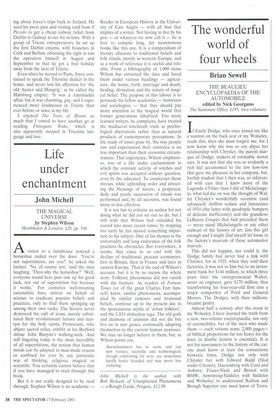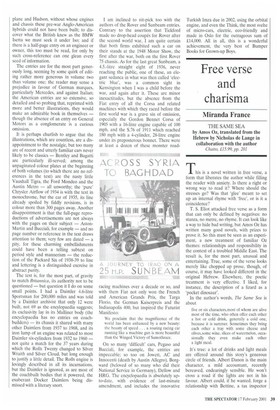The wonderful world of four wheels
Brian Sewell
THE BEAULIEU ENCYCLOPAEDIA OF THE AUTOMOBILE edited by Nick Georgano
The Stationery Office, £195, (two volumes)
If Emily Dodge, who once kissed me like a wanton on the back seat of my Wolseley, reads this, then she must forgive me, for I now know why she was so coy about her relationship with Chrysler, the parent marque of Dodge, makers of estimable motor cars. It was not that she was so evidently a rich kid accustomed to the low kow-tow that gave me pleasure in her company, but, foolish student that I then was, so infatuated with cars that I knew more of the Lagonda 4.5-litre than I did of Michelangelo, what led me on was the thought of Walter Chrysler's wonderfully eccentric (and advanced) Airflow sedans and limousines of 1934 (the latter with quadruple bumpers of delicate inefficiency) and the grandiose LeBaron Coupes that had preceded them — never mind Michelangelo or any other stalwart of the history of art, kiss this girl enough and I might find myself let loose in the factory's museum of these automotive marvels.
This did not happen, nor could it; the Dodge family had never had a link with Chrysler, for in 1925, when they sold their factories, it was not to him but to an investment bank for $146 million, to which three years later the entrepreneurial Walter, never an engineer, gave $170 million, thus transforming his four-year-old firm into a major competitor of Ford and General Motors. The Dodges, with their millions, became gentry.
Almost half a century after the event in my Wolseley, I have learned the truth from a new, two-volume encyclopaedia, not only of automobiles, but of the men who made them — each volume some 2,000 pages— of biblical proportions far too heavy for the knee (a double lectern is essential). It is not for newcomers to the history of the ear; one must know at least the connections between firms, Dodge not only with Chrysler but with Edward Budd (filed under Citroen), Duesenberg with Cord and Auburn, Frazer-Nash and Bristol with BMW, Armstrong-Siddeley with Siddeley and Wolseley; to understand Rai1ton and Brough Superior one must know of Terra plane and Hudson, without whose engines and chassis these pre-war Anglo-American hybrids could not have been built; to discover what the British knew as the BMW Isetta we must seek it under Iso; and if there is a half-page entry on an engineer or owner, this too must be read, for only by such cross-reference can one glean every seed of information.
The entries are for the most part generously long, seeming by some quirk of editing rather more generous in volume two than volume one; the reader may sense a prejudice in favour of German marques, particularly Mercedes, and against Italian; the American entries are so extensive, so detailed and so probing that, reprinted with more and better illustrations, they would make an admirable book in themselves — though the absence of an entry on General Motors as a conglomerate is a curious omission.
It is perhaps churlish to argue that the illustrations, which are countless, are a disappointment to the nostalgic, but too many are of recent and utterly familiar cars never likely to be classics — Bentley and Bugatti are particularly ill-served; among the unpaginated colour plates at the beginning of both volumes (to which there are no references in the text) are the nasty little Vauxhall Tigra, the Ford Mondeo and the Austin Metro — all unworthy; the 'pure' Chrysler Airflow of 1934 is with the text in monochrome, but the car of 1935, its line already spoiled by fiddly revisions, is in colour more than 300 pages away. Another disappointment is that the full-page reproductions of advertisements are not always with the pages on their subject — AstonMartin and Bucciali, for example — and no page number or reference in the text draws attention to them; very few are dated — a pity, for these charming embellishments could have been a telling subtext on period style and mannerism — the reduction of the Packard Six of 1938-39 to line and lettering is a distinguished exercise in abstract purity.
The text is, for the most part, of gravity to match Britannica, its authority not to be questioned — but question it I do on some small points. 1 had a Daimler 4.6-litre Sportsman for 200,000 miles and was told by a Daimler archivist that only 12 were built, not 69 as the encylopaedia suggests; its exclusivity lay in its MuHiner body (the encyclopaedia has no entries on coachbuilders) — its chassis it shared with many other Daimlers from 1937 to 1968, and its iron lump of an engine was related to most Daimler six-cylinders from 1932 to 1960 — not quite a match for the 37 years during which the Rolls Twenty changed to Silver Wraith and Silver Cloud, but long enough to justify a little detail. The Rolls engine is lovingly described in all its incarnations, but the Daimler is ignored, as are most of the coachbuilt bodies that it powered, the exuberant Docker Daimlers being dismissed with a literary snort.
I am inclined to nit-pick too with the authors of the Rover and Sunbeam entries. Contrary to the assertion that Tickford made no drop-head coupes for Rover after the second world war, I am quite certain that both firms exhibited such a car on their stands at the 1948 Motor Show, the first after the war, both on the first Rover 75 chassis. As for the last great Sunbeam, a 4.5.-litre straight eight of 1936, never reaching the public, one of these, an elegant sedanca in what was then called 'electric blue', was a common sight in Kensington when I was a child before the war, and again after it. These are minor inexactitudes, but the absence from the Fiat entry of all the Corsa and related machines with which they raced before the first world war is a grave sin of omission, especially the Gordon Bennet Corsa of 1905 with a 16-litre engine capable of 100 mph, and the S.76 of 1911 which reached 180 mph with a 4-cylinder, 28-litre engine under its preposterous bonnet. There were at least a dozen of these monster road racing machines over a decade or so, and with them Fiat not only won the French and American Grands Prix, the Targa Florio, the German Kaiserpreis and the Indianapolis 400, but inspired the Futurist Manifesto:
We proclaim that the magnificence of the world has been enhanced by a new beauty: the beauty of speed . . a roaring racing car running like a machine gun is more beautiful than the Winged Victory of Samothrace.
On so many 'difficult' cars, Pegaso and Bucciali, for example, the entries are impeccable; so too on Jowett, AC and Innocenti (death by Austin Allegro), Borgward (beloved of so many who did their National Service in Germany), Dellow and HRG. The encyclopaedia is absolutely upto-date, with evidence of last-minute amendment, and includes the innovative
Turkish Imza due in 2002, using the orbital engine, and even the Think, the most svelte of micro-cars, electric, eco-friendly and made in Oslo for the outrageous sum of £14,000. All in all, this is a wonderful achievement, the very best of Bumper Books for Grown-up Boys.



































































 Previous page
Previous page